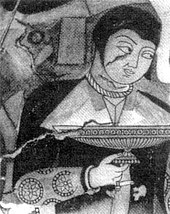Balalyk Tepe
37°32′07″N 67°06′55″E / 37.535384°N 67.115405°E Balalyk tepe, in former
Murals
The theme of the Balalyk-tepe is uniformly related to feasting.
The men in the paintings are beardless and the women have rounded features.[7] They are adorned with splendid costumes and beautiful jewelry.[7]
The paintings seem to depict the
The paintings of Balalyk Tepe are very similar to those of

-
Figure of a banquet, Balalyk Tepe, 6th-7th century CE
-
Balalyk tepe Banquet scene, 6-7th century CE
-
Balalyk tepe Banquet scene, 6-7th century CE
-
Balalyk tepe Banquet scene, 6-7th century CE
Attribution

Many authors have suggested that the figures in the Balalyk Tepe paintings are characteristic of the Hephthalites (450-570 CE).[13] In this context, parallels have been drawn with the figures from Kizil Caves in Chinese Turkestan, which seem to wear broadly similar clothing. The paintings of Balalyk Tepe would be characteristic of the court life of the Hephthalites in the first half of the 6th century CE, before the arrival of the Turks.[14][15]
The paintings of Balalyk Tepe are also sometimes attributed to the time after the arrival of the
Numismatic parallels

Some attempts have been made at identifying similarities between the types of Balalyk Tepe and the portraits on coins of the region. In some coins from Chach, modern
Michael Fedorov attributed this type of coinage to the
Other authors have attributed these coins to the next period, between 625 and 725 CE, corresponding to the control of the area of Chach by the
See also
- Tavka Kurgan
- Penjikent
- Dalverzin Tepe
- Kara Tepe
- Fayaz Tepe
References
- ^ ISBN 978-92-3-103211-0.
- ^ "The exacavations at Balalik Tepe (...) revealed the remains of a small fortified manor that was the seat of a princely Hephthalite clan." in Rowland, Benjamin (1975). The art of Central Asia. New York, Crown. p. 75.
- JSTOR 24049243.
- ISBN 978-81-208-1540-7.
- ^ "The Tokharistan school was represented by Balalyk-tepe, Adzhina-tepe, Kafyr-kala; the northern Tokharistan school was found in the Buddhist Temples of Kuva and in Jeti-su" Kurbanov, Aydogdy (2014). "THE HEPHTHALITES: ICONOGRAPHICAL MATERIALS" (PDF). Tyragetia: 317–334.
- ^ ISBN 978-0-520-03765-6.
- ^ a b c d e f Frumkin, Grégoire (1970). Archaeology in Soviet Central Asia. Brill Archive. pp. 116–117.
- ISBN 978-0-520-03765-6.
- ISBN 978-0-520-03765-6.
- ISBN 978-92-3-103211-0.
- ^ "Furthermore, the style of the later paintings [of Diberjin Tepe], which are comparable to those of Balalyk Tepe and to the oldest frescoes at Panjīkant, both in Sogdia, indicates a date in the 5th-6th centuries C.E., according to some authorities (Belenitskiĭ and Marshak), whereas others argue from the numismatic finds that the final phase cannot have been later than the end of the 4th or the early 5th century C.E. (Vaĭnberg and Kruglikova, 1976; idem, 1984; Pugachenkova, 1984, p. 105).""DELBARJĪN – Encyclopaedia Iranica". www.iranicaonline.org.
- ISBN 978-0-910081-01-6.
- ^ Kurbanov, Aydogdy (2014). "THE HEPHTHALITES: ICONOGRAPHICAL MATERIALS" (PDF). Tyragetia: 317–334.
- ^ "Several murals at Dilberjin date from the 5th to the 7th century. A comparison between some of the Dilberjin paintings and those at Kyzyl (“the cave of the 16 swordsmen” and “the cave with picture of Maya”) demonstrates a link between them (Litvinsky 1996, 151)." Kurbanov, Aydogdy (2014). "THE HEPHTHALITES: ICONOGRAPHICAL MATERIALS" (PDF). Tyragetia: 317–334.
- ^ Frumkin, Grégoire (1970). Archaeology in Soviet Central Asia. Brill Archive. pp. 116–118.
- ISBN 978-0-300-09038-3.
- JSTOR 1523200.
- ^ S2CID 163653671.
- ^ Shagalov, V.D.; Kuznetsov, A.V. (2006). Catalogue of coins of Chach III-VIII AD. Tashkent. pp. 184, 313–315.
{{cite book}}: CS1 maint: location missing publisher (link) - JSTOR 42666952.












